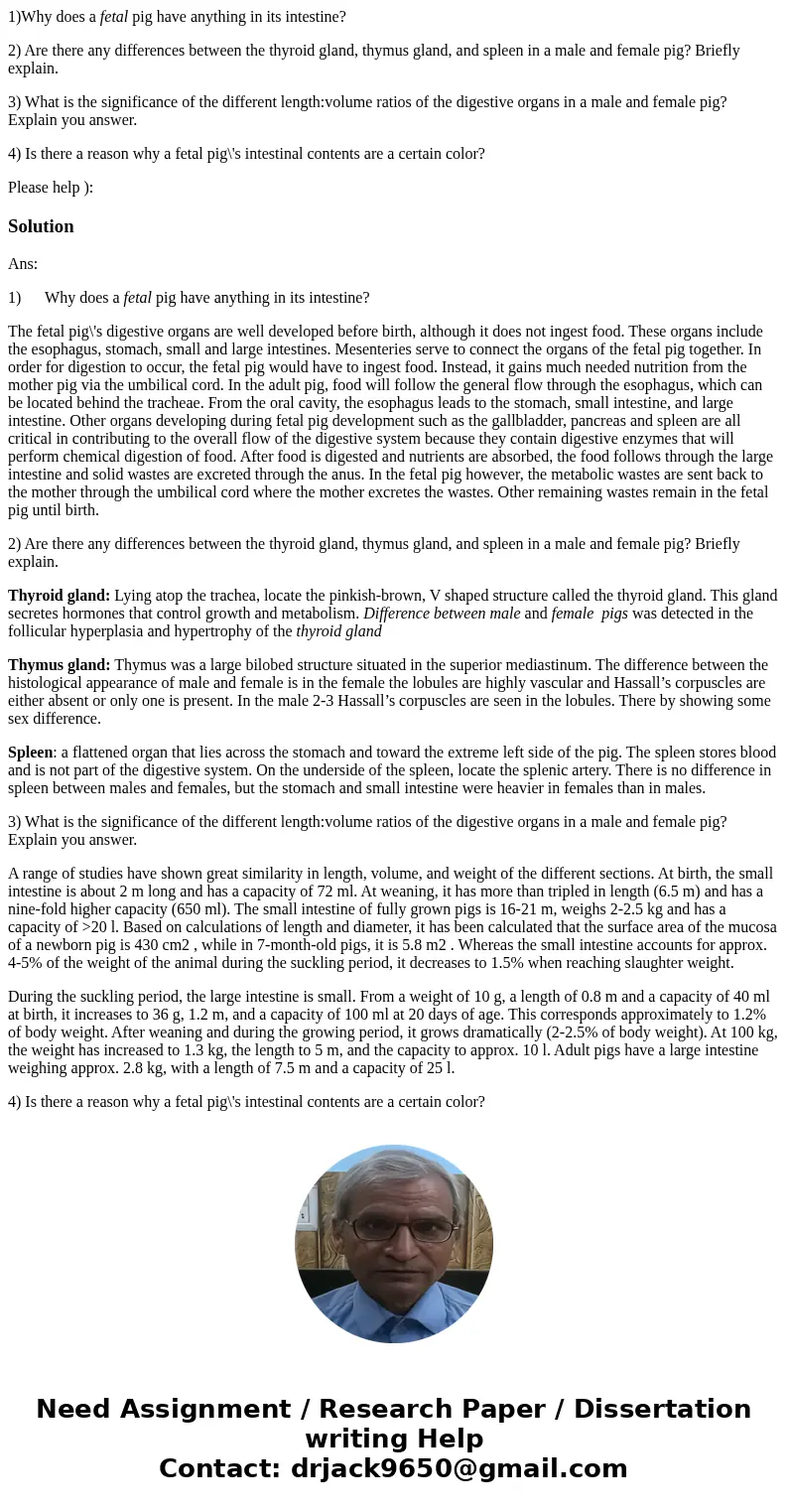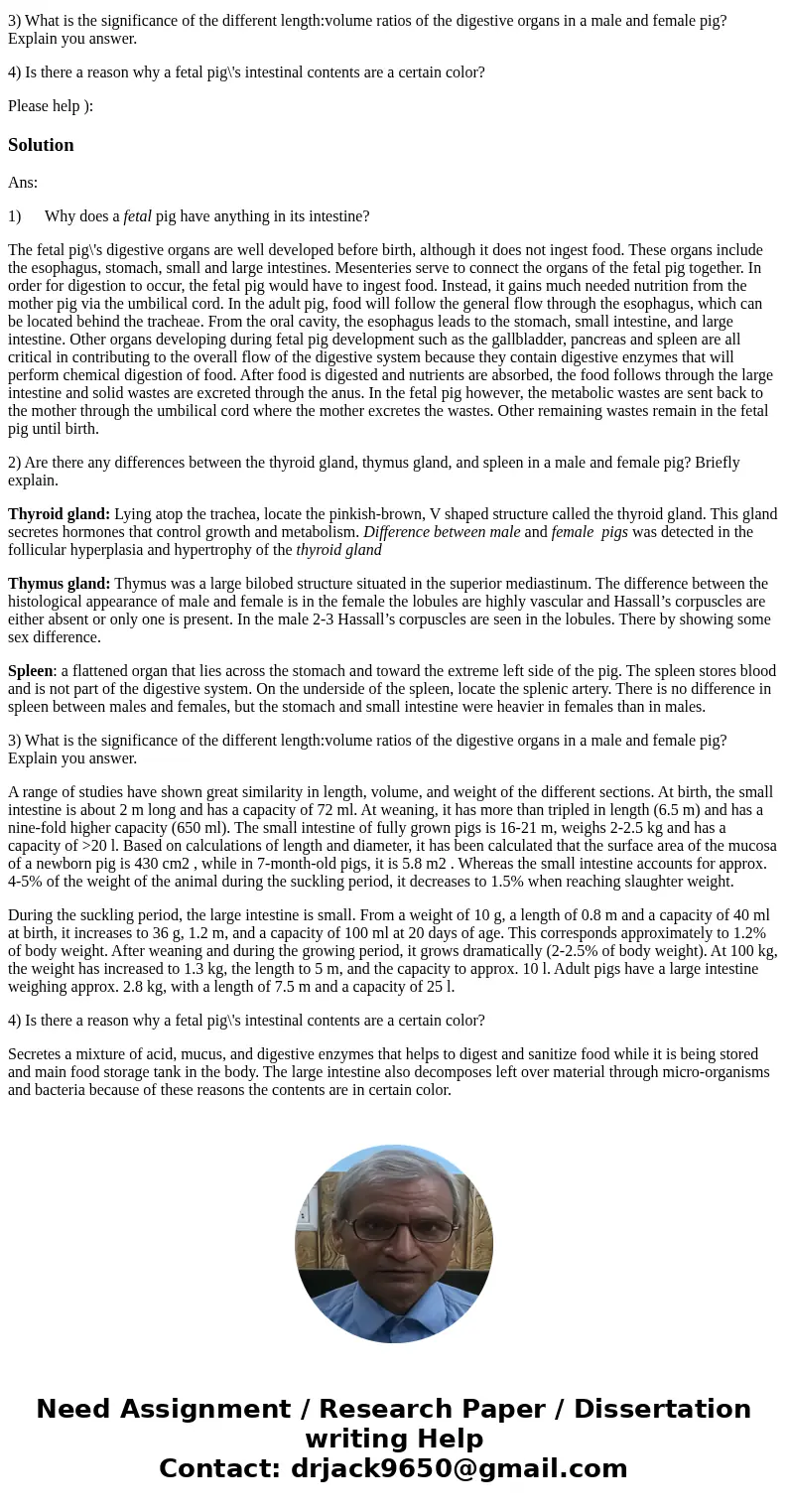1Why does a fetal pig have anything in its intestine 2 Are t
1)Why does a fetal pig have anything in its intestine?
2) Are there any differences between the thyroid gland, thymus gland, and spleen in a male and female pig? Briefly explain.
3) What is the significance of the different length:volume ratios of the digestive organs in a male and female pig? Explain you answer.
4) Is there a reason why a fetal pig\'s intestinal contents are a certain color?
Please help ):
Solution
Ans:
1) Why does a fetal pig have anything in its intestine?
The fetal pig\'s digestive organs are well developed before birth, although it does not ingest food. These organs include the esophagus, stomach, small and large intestines. Mesenteries serve to connect the organs of the fetal pig together. In order for digestion to occur, the fetal pig would have to ingest food. Instead, it gains much needed nutrition from the mother pig via the umbilical cord. In the adult pig, food will follow the general flow through the esophagus, which can be located behind the tracheae. From the oral cavity, the esophagus leads to the stomach, small intestine, and large intestine. Other organs developing during fetal pig development such as the gallbladder, pancreas and spleen are all critical in contributing to the overall flow of the digestive system because they contain digestive enzymes that will perform chemical digestion of food. After food is digested and nutrients are absorbed, the food follows through the large intestine and solid wastes are excreted through the anus. In the fetal pig however, the metabolic wastes are sent back to the mother through the umbilical cord where the mother excretes the wastes. Other remaining wastes remain in the fetal pig until birth.
2) Are there any differences between the thyroid gland, thymus gland, and spleen in a male and female pig? Briefly explain.
Thyroid gland: Lying atop the trachea, locate the pinkish-brown, V shaped structure called the thyroid gland. This gland secretes hormones that control growth and metabolism. Difference between male and female pigs was detected in the follicular hyperplasia and hypertrophy of the thyroid gland
Thymus gland: Thymus was a large bilobed structure situated in the superior mediastinum. The difference between the histological appearance of male and female is in the female the lobules are highly vascular and Hassall’s corpuscles are either absent or only one is present. In the male 2-3 Hassall’s corpuscles are seen in the lobules. There by showing some sex difference.
Spleen: a flattened organ that lies across the stomach and toward the extreme left side of the pig. The spleen stores blood and is not part of the digestive system. On the underside of the spleen, locate the splenic artery. There is no difference in spleen between males and females, but the stomach and small intestine were heavier in females than in males.
3) What is the significance of the different length:volume ratios of the digestive organs in a male and female pig? Explain you answer.
A range of studies have shown great similarity in length, volume, and weight of the different sections. At birth, the small intestine is about 2 m long and has a capacity of 72 ml. At weaning, it has more than tripled in length (6.5 m) and has a nine-fold higher capacity (650 ml). The small intestine of fully grown pigs is 16-21 m, weighs 2-2.5 kg and has a capacity of >20 l. Based on calculations of length and diameter, it has been calculated that the surface area of the mucosa of a newborn pig is 430 cm2 , while in 7-month-old pigs, it is 5.8 m2 . Whereas the small intestine accounts for approx. 4-5% of the weight of the animal during the suckling period, it decreases to 1.5% when reaching slaughter weight.
During the suckling period, the large intestine is small. From a weight of 10 g, a length of 0.8 m and a capacity of 40 ml at birth, it increases to 36 g, 1.2 m, and a capacity of 100 ml at 20 days of age. This corresponds approximately to 1.2% of body weight. After weaning and during the growing period, it grows dramatically (2-2.5% of body weight). At 100 kg, the weight has increased to 1.3 kg, the length to 5 m, and the capacity to approx. 10 l. Adult pigs have a large intestine weighing approx. 2.8 kg, with a length of 7.5 m and a capacity of 25 l.
4) Is there a reason why a fetal pig\'s intestinal contents are a certain color?
Secretes a mixture of acid, mucus, and digestive enzymes that helps to digest and sanitize food while it is being stored and main food storage tank in the body. The large intestine also decomposes left over material through micro-organisms and bacteria because of these reasons the contents are in certain color.


 Homework Sourse
Homework Sourse